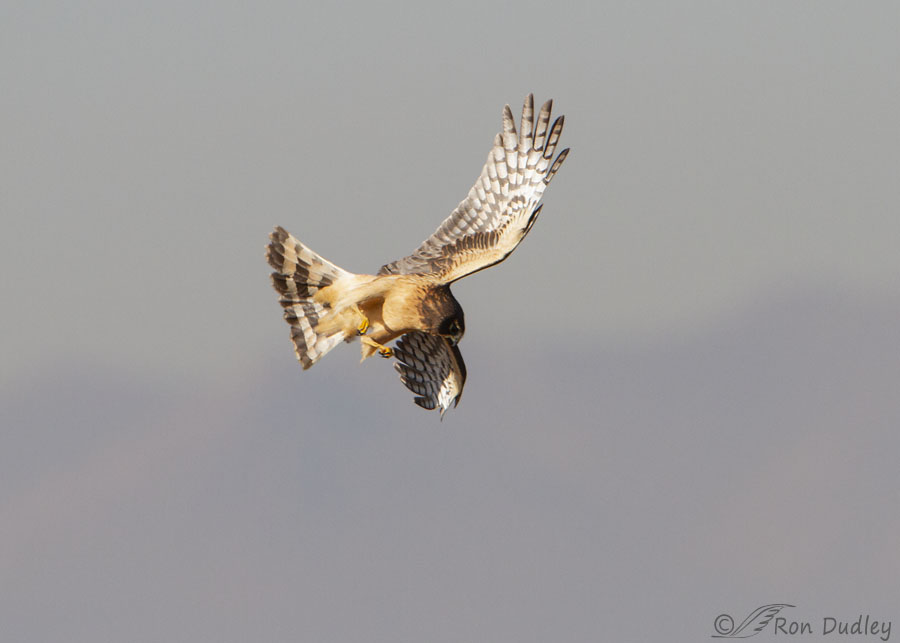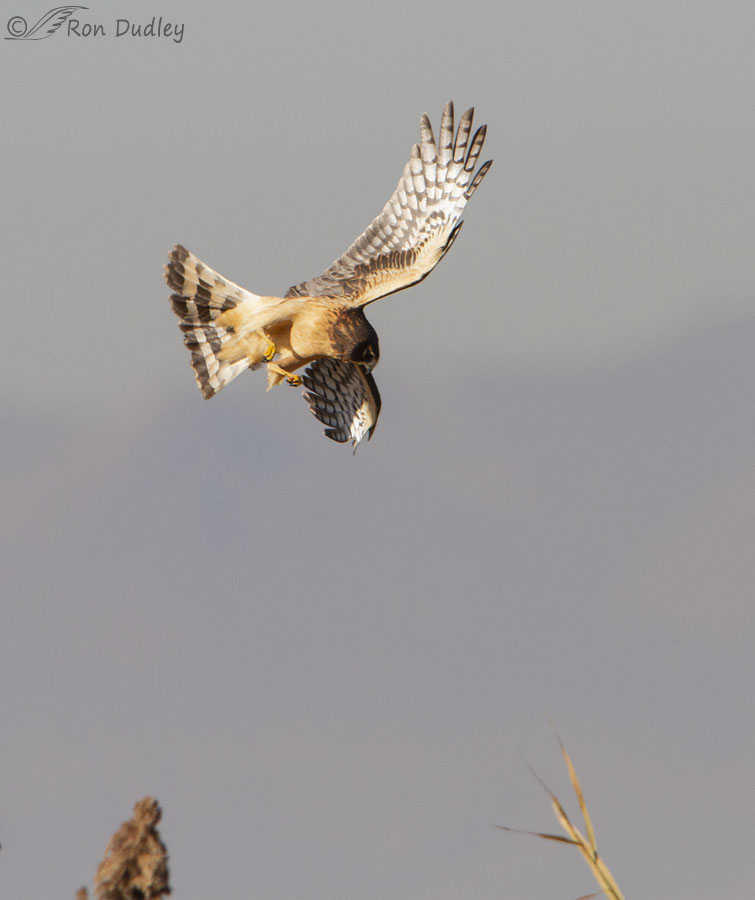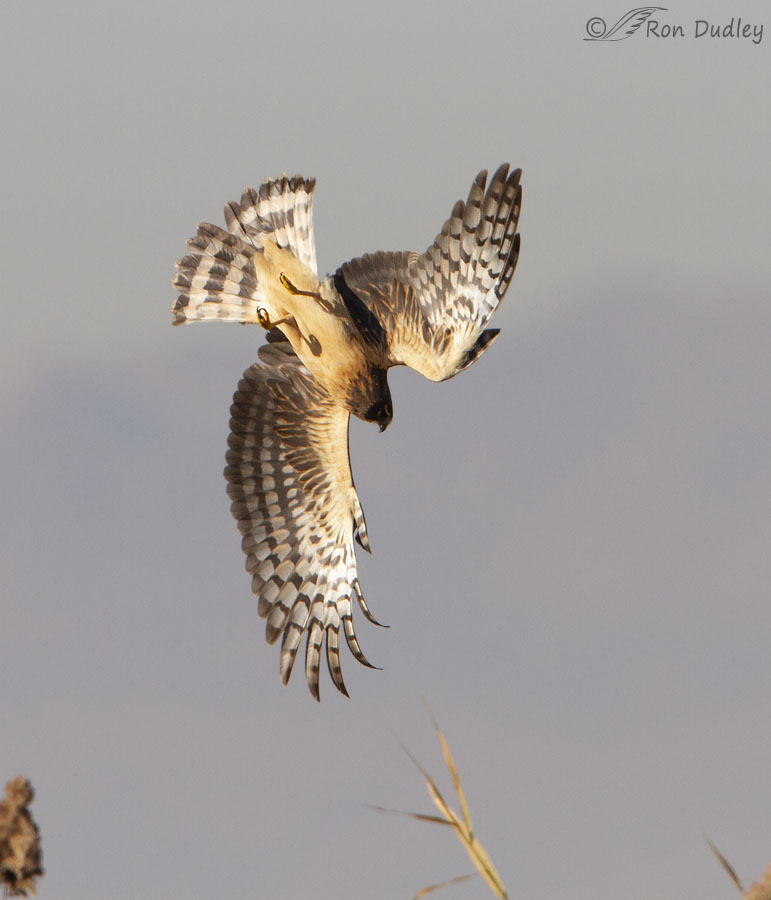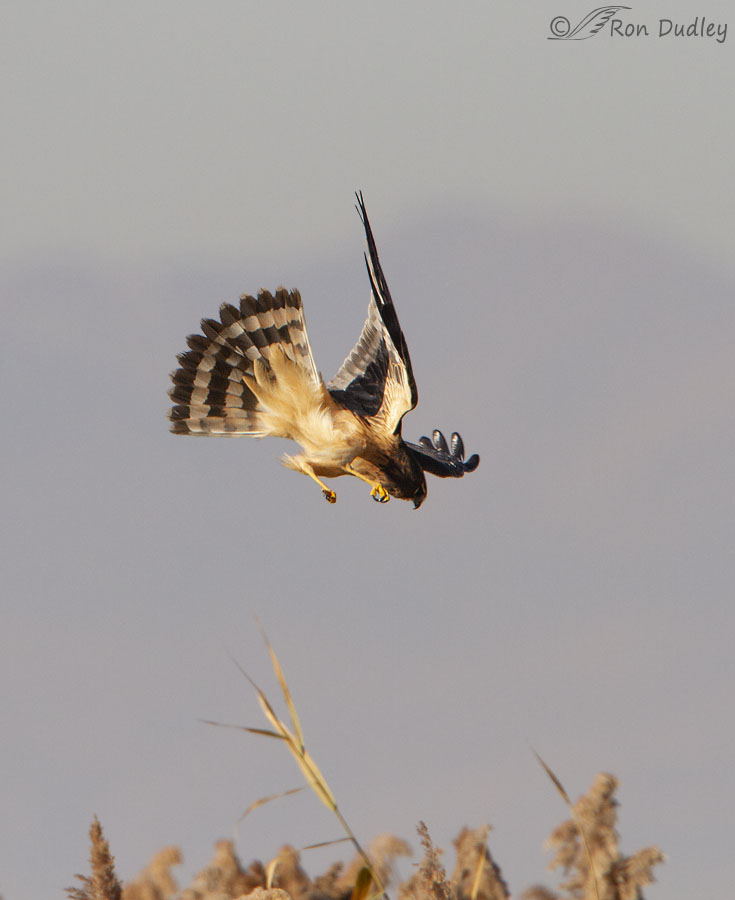I see this maneuver from Northern Harriers often and every time I’m awed by it.
Without question I’ve spent more time over the years watching and photographing Northern Harriers than I have any other raptor. I’ve chosen my vanity license plate (HARRIER) for that very reason. But photographing this aerial hunting maneuver is incredibly difficult because they change direction and speed so very fast it’s almost impossible to keep them in frame, much less in focus.
The following series of 3 photos is the best I’ve ever managed at documenting the maneuver. They were taken ten years ago (11/17/09) at Farmington Bay WMA so they’re from what Marty K. calls the “Dudley Wayback Machine”.

1/2000, f/7.1, ISO 500, Canon 7D, Canon EF 500mm f/4L IS II USM + EF 1.4 III Extender, not baited, set up or called in
I’m disappointed that I don’t have a shot of the harrier in flight before the maneuver began but she was still far enough away that I wasn’t taking any photos yet. But a split second prior to this shot she had been flying almost directly toward me and aimed over my right shoulder.
When she spotted potential prey directly below her she began her twisting maneuver designed to instantly stop her forward momentum so she could dive straight down on it. Many hawks hunt on the wing but generally they do it from a fairly high elevation so they have maneuvering distance between them and the prey as they descend on it.
Not so with harriers. They generally hunt very close to the ground and vegetation.

A vertical crop of the previous image reveals how close she was to the top of the thick stand of phragmites when she first spotted the prey directly below her and began to stop her forward momentum. Here she’s still moving forward but she’s beginning to apply the brakes as she looks straight down at the prey (most likely a vole but possibly a small bird).

1/2500, f/7.1, ISO 500, Canon 7D, Canon EF 500mm f/4L IS II USM + EF 1.4 III Extender, not baited, set up or called in
In the next shot in the burst her air brakes are fully applied with the large surface areas of her plumage turned broadside to the direction she’d been traveling in order to achieve as much air resistance as possible. Her simultaneous twisting maneuver allowed her to keep her eye on the prey directly below her and begin her dive.

1/2500, f/7.1, ISO 500, Canon 7D, Canon EF 500mm f/4L IS II USM + EF 1.4 III Extender, not baited, set up or called in
With her forward momentum stopped she’s now just beginning to drop straight down on her intended victim.
Notice that between this shot and the previous one she’s only lost a few inches of elevation. But immediately after this shot was taken she dropped like a rock, so quickly that she was out of frame when my shutter clicked the next time (in a burst my older Canon 7D only took 8 frames/sec instead of the 10 frames/sec of my current 7D Mark II. Frame rate matters to bird photographers).
When I’m watching them hunt in real time I find it hard to believe that they can perform this maneuver so incredibly fast but their less robust bodies, light weight and relatively large surface area of wings and tail allows them to pull it off using their resulting buoyant, gliding and slow flight.
Unlike other hawks Northern Harriers rely heavily on auditory cues as well as visual ones to detect and capture prey so hunting so close to the ground and vegetation is a huge advantage for them.
And that requires incredible agility and maneuverability to be successful.
Ron


I’m relatively new to your blog, so this is the first post I’ve seen on Harriers. These photos are amazing, and I also enjoyed your description of the details of the maneuver. Northern Harriers are one of my favorite raptors to watch in flight, and fortunately they often hunt the wetlands and steppe behind my house. I find the adult males really striking, although I haven’t seen one in a while. If you have any nice shots of a male Harrier, I’d love to see you pull those out sometime.
Bill, I’ve probably posted hundreds of what I consider “nice shots” or better of male harriers to my blog. If you’re interested in seeing some of them use the search box at the upper right of my blog and type in “gray ghost” which is what male harriers are often called. Dozens of posts should come up if you go from page to page. Only 2 links show up per page. You have to keep clicking on “older posts” to continue bringing up the links.
Amazing that you were able to catch this!
Thanks, Patty.
And tagging onto Laura’s comments and your response to her.
Ten years ago I saw a Red-tailed Hawk drop straight down about 150 feet at great speed (for a redtail dive), pouncing onto prey in the dried grass median of local highway. After striking the earth, she bounced up about a foot and a half. I’d never seen anything close to it, still haven’t and I’m always looking.
That brings back a memory for me too, Dave. I saw something similar happen years ago. Can’t remember what species of raptor it was but that bird really bounced.
Well, those last two shots really punctuate this series so brilliantly. Very well captured and described.
“Frame rate matters…”, I like that line a lot.
Congratulations on finding Harrier gold in your wayback machine.
Cheers to you Ron
Dave, that “frame rate matters” line probably came to my mind for two reasons: because it really DOES matter in situations like this and because I’ve been spending a lot of time lately looking for a new camera that will suit my needs and striking out (one of my needs is a fast frame rate). It’s been a frustrating experience. I’m really pissed off at Canon for discontinuing the 7D line. They’ve essentially abandoned a large segment of bird photographers.
Wow, that’s pretty brutal! I have to admit that I often have “Canon envy” over some of the refined aspects of their products. But I went Nikon and am happy with my D500 in most regards (struggling to enter retirement and get my f4 500mm lens), the operator less so at times.
I hope Nikon doesn’t go this route and I hope Canon corrects their blunder and soon!
What beautiful maneuvers. So impressive that you caught them. To paraphrase a line from a film, it looks like “It is Beauty that’s about to kill the Beast”.
Thank you, Lyle.
I was delighted to see the first Harrier of the season in the field before I released Jack the other day!! Like you, I love watching their fancy flying, and since they’re not interested in challenging Jack, it’s good to share the field with them. I keep wondering if they’ll join us, maybe catching something Jack misses in a wild falconry kind of scenario!
But Harriers aren’t the only ones with those moves! Redtails, Harris’ hawks and Kestrels are also skilled at those sorts of amazing dives. You just gotta trust me on this.
Oh, I agree, Laura – several butteos are capable of the moves. They just don’t do it nearly as fast. And they usually do it from greater heights than harriers. And at least technically kestrels are falcons, not hawks.
Wow. ABsoLUTEly STUNNING! THANK you for sharing those amazing shots & super helpful/edifying description of what’s going on. WHAT a delight. Great work!! =D
Thanks very much, Samantha.
Excellent series. Your skill is amazing. I don’t know if you caught a story Sunday night on 60 Minutes. It is very interesting about a young woman from Oklahoma who as a teenager discovered hunting with Golden Eagles, took herself to Mongolia and is now a very accomplished falconer. I was so impressed with the segment I can’t stop thinking about it. Have a great week.
Betty, yes I’ve seen that 60 minutes report. Fascinating stuff.
Awe. Wonder. Delight.
And a smidge of jealousy.
Thanks, EC.
All I have is WOW

This is why flying would be my secret power
Diana, If I could fly I sure wouldn’t keep it a secret!
To you, it may be an old series, but to my eye, it is the most stunning I’ve yet seen–absolutely DYNAMIC ! I especially admired the light and shadows
on the bird itself, and the grey sky background worked as a wonderful foil to all the drama in the bird’s plunge !
Kris, yes it’s an old series but I like it a lot too, especially the second to the last photo. Thanks.
Having so often failed to get photos like these Ron I have enormous admiration for your skills to be able to do it so successfully. These are outstanding shots. This is not like an osprey who stops a few hundred feet up in the air over a lake and then signals the dive by going into a pre dive flutter, this is something that often happens in a matter of seconds just a few feet off the ground. Those last two shots are amazing. You have a chance to catch an eagle or osprey in a dive the moment you see them start, but with a Harrier you have to already have them in your frame when they dive.
There are evidently hundreds if not thousands of treasures like these in your archives aka “The Dudley Wayback Machine.”
Thanks, Everett. I’m sure there’s still some undiscovered treasures in there but finding them is the trick.
WOW! They are amazing to watch when the go from a slow glide to “boom” down they go! Wonderful you were able to capture as much as you did! Appears she may have already laid left talon on something in the recent past – blood? Snow melting here(37 this morning) and roads are mostly good – appears it’s still ugly up N with severe driving conditions…..
Wonderful you were able to capture as much as you did! Appears she may have already laid left talon on something in the recent past – blood? Snow melting here(37 this morning) and roads are mostly good – appears it’s still ugly up N with severe driving conditions…..  They just can’t catch a break this fall……
They just can’t catch a break this fall……
Looks like possible blood to me too, Judy.
I looked at the Glacier Electric webcam in Cut Bank yesterday. It looked like absolutely miserable weather with lots of blowing snow.